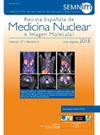Análisis de variables dosimétricas y clínicas en el tratamiento de los tumores neuroendocrinos con [177Lu]Lu-DOTA-TATE
IF 1.6
4区 医学
Q3 RADIOLOGY, NUCLEAR MEDICINE & MEDICAL IMAGING
Revista Espanola De Medicina Nuclear E Imagen Molecular
Pub Date : 2025-03-10
DOI:10.1016/j.remn.2024.500089
引用次数: 0
Abstract
Purpose
The main objectives were to study differences between the first and the fourth cycle in dosimetry variables in patients treated for neuroendocrine tumours with four cycles of [177Lu]Lu-DOTA-TATE, as well as to look for absorbed dose–effect correlations aiming to help individualise and optimise this therapy for future patients.
Material and methods
SPECT based dosimetry of tumour lesions and kidneys was performed in the first and the fourth cycles of the [177Lu]Lu-DOTA-TATE treatments for 17 patients from 2020 to 2023. Clinical variables of interest were collected in order to look for correlations with some dosimetry variables. Statistical analysis was performed using the R software.
Results
Regarding dosimetry variables, for lesions a significant decrease in absorbed dose, mass and initial activity between the first and fourth cycles was observed. For kidneys, a significant increase in absorbed dose was observed. Effective decay constants did not significantly change neither for lesions nor for kidneys. The relative decrease in lesion masses correlated with their total absorbed dose. Total absorbed doses to kidneys were well below the toxicity limits mostly used in this therapy. Relative decr
ease in lesion absorbed doses was significantly lower for tumour primary sites in ileum and jejunum compared to those in pancreas. Moreover, radiological response correlated with clinical response.
Conclusions
The results seem to indicate that the current treatment scheme could be optimised in order to obtain better treatment outcomes.
使用[177Lu]Lu-DOTA-TATE治疗神经内分泌肿瘤的剂量和临床变量分析
目的:主要目的是研究使用[177Lu]Lu-DOTA-TATE四个周期治疗神经内分泌肿瘤患者的第一和第四个周期剂量学变量之间的差异,以及寻找吸收剂量效应相关性,旨在帮助个性化和优化未来患者的治疗。材料与方法在2020年至2023年期间,对17例患者进行了[177Lu]Lu-DOTA-TATE治疗的第一和第四周期的肿瘤病变和肾脏进行了基于spect的剂量测定。收集感兴趣的临床变量,以寻找与一些剂量学变量的相关性。采用R软件进行统计分析。结果在剂量学变量方面,观察到病变在第一个和第四个周期之间的吸收剂量、质量和初始活性显著降低。对于肾脏,观察到吸收剂量显著增加。病变和肾脏的有效衰变常数均无显著变化。病灶肿块的相对减小与其总吸收剂量有关。肾脏的总吸收剂量远低于该疗法中主要使用的毒性限度。肿瘤原发部位回肠和空肠的病变吸收剂量相对降低明显低于胰腺。此外,放射反应与临床反应相关。结论可以对目前的治疗方案进行优化,以获得更好的治疗效果。
本文章由计算机程序翻译,如有差异,请以英文原文为准。
求助全文
约1分钟内获得全文
求助全文
来源期刊

Revista Espanola De Medicina Nuclear E Imagen Molecular
RADIOLOGY, NUCLEAR MEDICINE & MEDICAL IMAGING-
CiteScore
1.10
自引率
16.70%
发文量
85
审稿时长
24 days
期刊介绍:
The Revista Española de Medicina Nuclear e Imagen Molecular (Spanish Journal of Nuclear Medicine and Molecular Imaging), was founded in 1982, and is the official journal of the Spanish Society of Nuclear Medicine and Molecular Imaging, which has more than 700 members.
The Journal, which publishes 6 regular issues per year, has the promotion of research and continuing education in all fields of Nuclear Medicine as its main aim. For this, its principal sections are Originals, Clinical Notes, Images of Interest, and Special Collaboration articles.
 求助内容:
求助内容: 应助结果提醒方式:
应助结果提醒方式:


